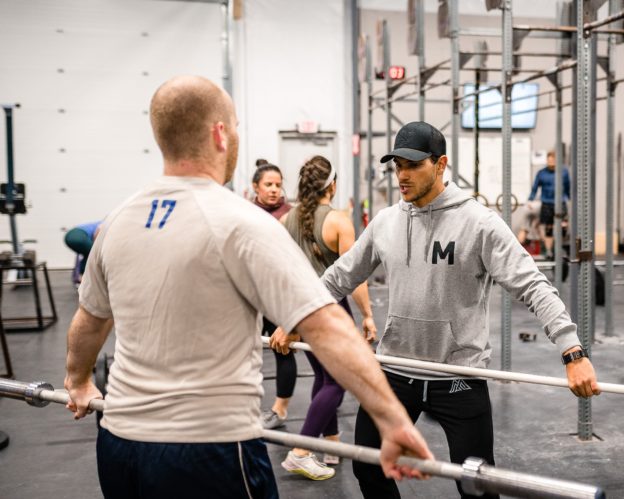
How to Program and Run a 12 Days of Christmas Workout
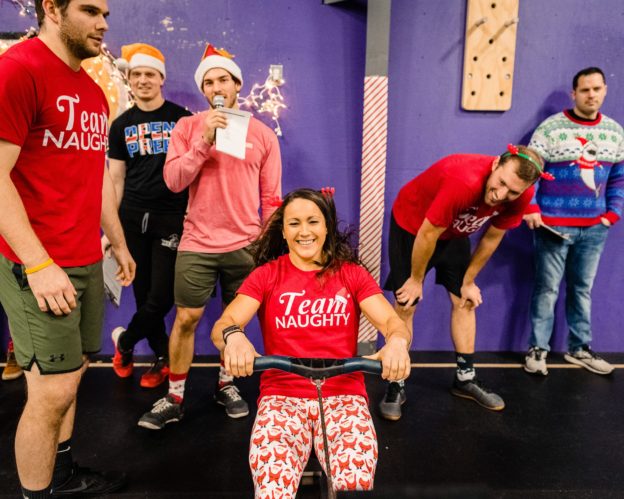
I’ll be honest, programming the annual 12 Days of Christmas workouts isn’t one of my favorite things to do. Not because I don’t like the workout itself, but from a programming and coaching perspective it uses a lot of movements that need to be carefully placed in the rep scheme, usually has a heavy equipment burden, and is typically a longer workout making it more logistically challenging to run effectively in a class. Fortunately, there are a few easy ways to get around these three issues whether you’re snagging someone else’s idea (like ours below) or are programming it yourself. Here are a few things to consider as you put together your annual chipper.
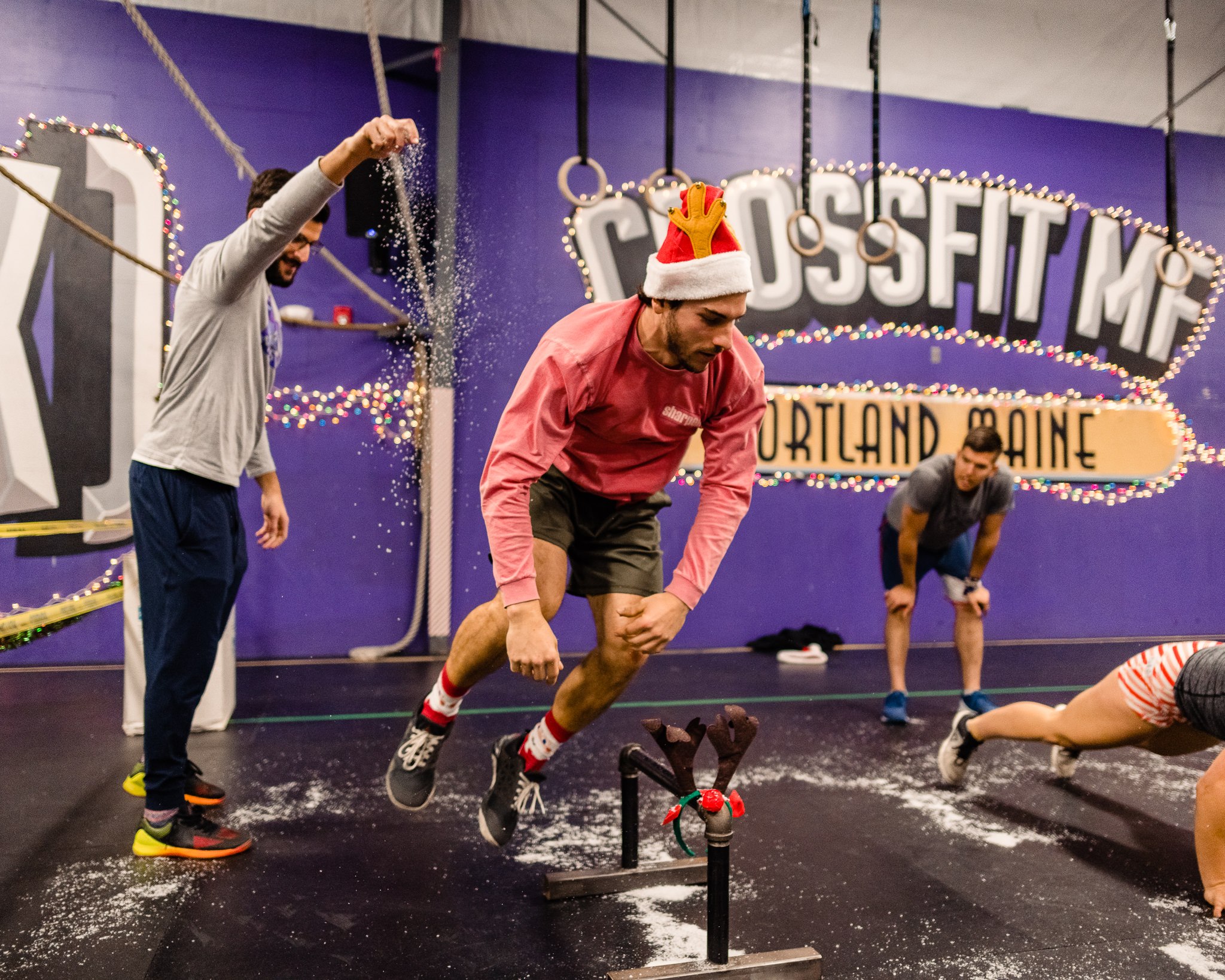
Movement Usage and Rep Breakdown
Movement usage is a pretty simple idea – if you’re going to use 12 different movements you have to be mindful of repeated movement patterns (e.g. pulling off the floor, squatting, overhead) both within the workout itself and within the context of the rest of your gym’s programming that week. Yes, most athletes are going to do their 12 Days workout and then probably rest for a day or two, but that doesn’t mean we need athletes accumulating excessive overall volume, specifically in the same movement patterns just because there’s a rest day coming up.
Second, understanding the rep breakdown in a 12 Days workout is a little more informative. Assuming you’re having athletes execute the workout “like the song” (1 rep, then 2-1, then 3-2-1, then 4-3-2-1, etc. finishing with 12-11-…2-1), you’re looking at a total volume of 364 possible reps (I say possible because there’s a difference between one thruster rep and one calorie on a machine with respect to potential soreness/CNS demand). That being said, the way that the workout is executed means that the movements in the middle 4 rounds (5, 6, 7, and 8) consist of nearly half (45%) the total volume of the workout. This can be helpful when thinking about the placement of movements, as those middle rounds can dictate whether athletes keep cruising or get slowed down due to metabolic fatigue or muscular overload. Placing gymnastics movements or metabolically demanding barbell movements that are likely to slow athletes down in the 4-8 spot of the workout will likely result in a longer workout or a different stimulus than what you were hoping for. This is also the place to be mindful of similar movement patterns since they’re not only back to back, but account for the bulk of the workout’s volume. For example, might be unwise to put movements like burpees, HSPU, jerks, and push ups in those slots as they all are predominantly pressing movements. Below is a rep breakdown of the 12 Days of Christmas workout, or you can download the PDF version at the bottom of this post.
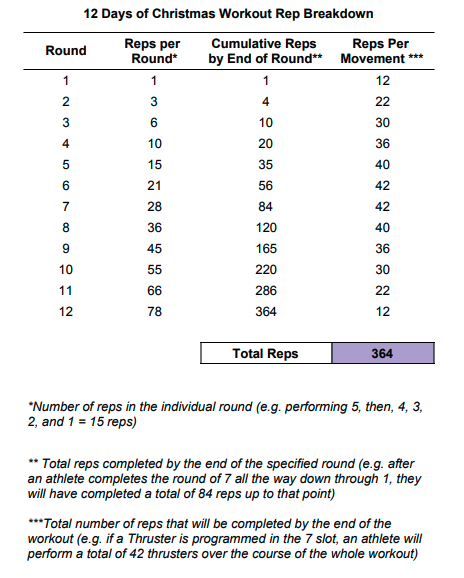
Equipment Requirement
Like I said, programming a 12 Days of Christmas workout means you could be looking at 12 different movements. Of course, not every movement is going to have its own piece of equipment – a barbell for one movement could of course be used for another, but usually we’ll use more than the usual 2-3 movements as in a classic couplet or triplet. If you have a big space and a lot of equipment relative to your number of athletes, maybe this isn’t an issue. If these things are a concern for you, an easy way around this is to either repeat movements like in example 1, or try to make sure the same equipment is used for multiple different movements in example 2.
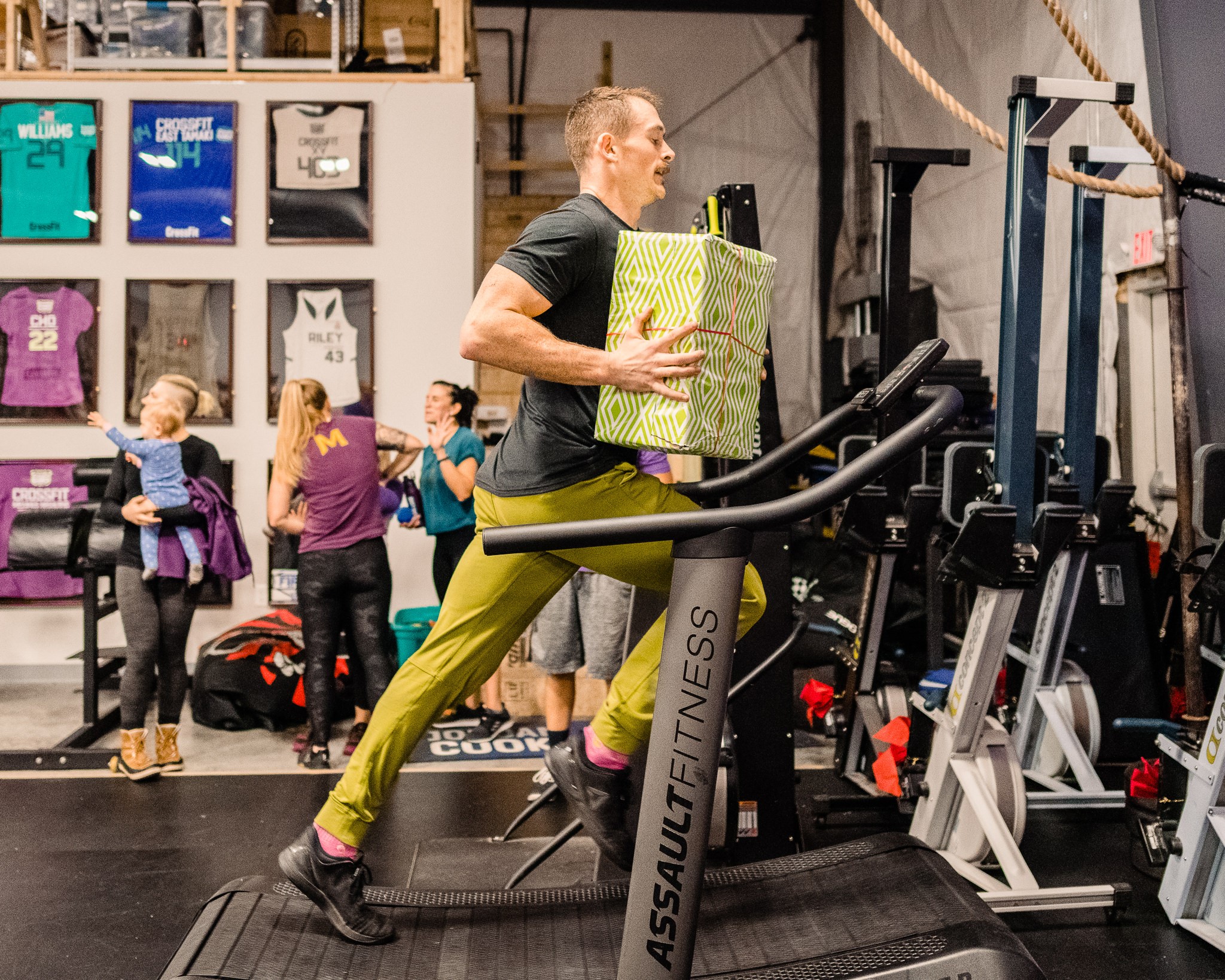
Example 1
2018 12 Days of Gainzmas
1 DB Box Step Over
2 S-Arm DB Hang Clean and Jerk
3 DB Facing Burpee
4 DB Box Step Over
5 S-Arm DB Hang Clean and Jerk
6 DB Facing Burpee
7 DB Box Step Over
8 S-Arm DB Hang Clean and Jerk
9 DB Facing Burpee
10 DB Box Step Over
11 S-Arm DB Hang Clean and Jerk
12 DB Facing Burpee
DB weight: 20-60lbs
Box: 24/20”
Example 2
2020 12 Days of Misfit-mas
1 Single DB Step Up
2 Bar Muscle Up
3 Bike Meters x100 (300m)
4 Single DB Step Ups
5 Strict Pull Ups
6 Bike Meters x100 (600m)
7 Single DB Step Ups
8 Toes to Bar
9 Bike Meters x100 (900m)
10 Single DB Step Ups
11 S-Arm DB Cluster
12 Bike Meters x100 (1200m)
Dumbbell: 70/50lbs
Box: 24/20″
Partner Option: Perform all DB movements Synchro and perform the Bike and Gymnastic as you-go, I-go. (e.g. I do 8 toes to bar, then my partner does 8 toes to bar. Then we perform 7 synchro step ups, then I bike 600m and then my partner bikes 600m).
Example 1 is our 2018 workout and was a fun twist that only used 3 movements instead of the usual 12, and created a pretty uncomfortable stimulus with a very small footprint – a dumbbell, a box, and enough space for some burpees. Example 2 is a little more robust, but still follows a similar pattern of machine distance followed by a pull up bar movement and then a single dumbbell movement, making the equipment requirement relatively low at a bike or machine, one box, one dumbbell, and one pull up bar spot. There’s also a partner version of this year’s workout, but note that it will likely take longer as there are times when one athlete is working while the other is resting.
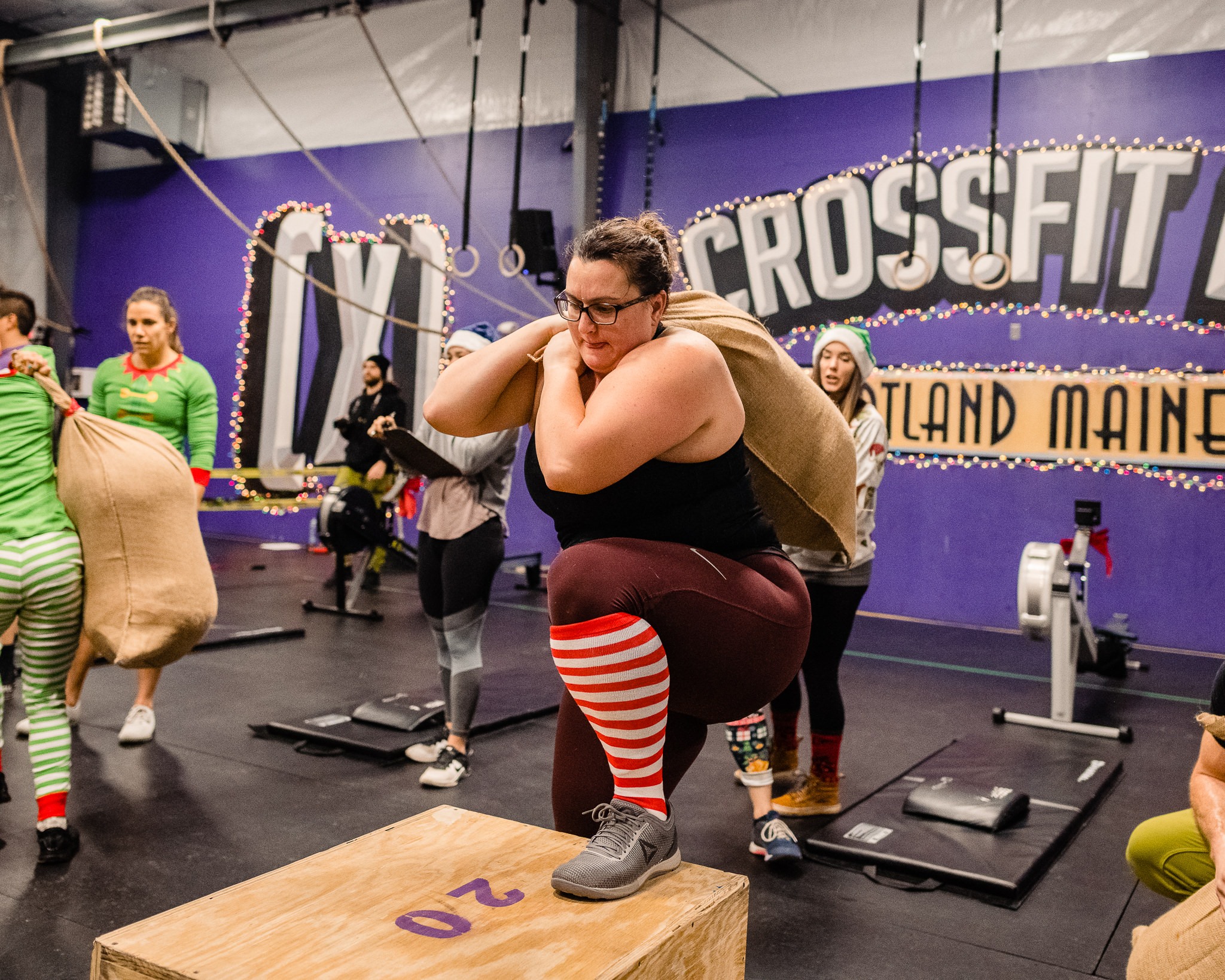
12 Days in a 60 Minute Class
For all the reasons above, running a 12 Days workout in a standard 60 minute class can be challenging, but there are a few ways to make doing so easier.
- Have athletes grab the equipment they need for the warm up/workout before class starts. An often overlooked time-suck in class is athletes retrieving needed equipment and bringing it back to their spot. Especially with many gyms implementing social distancing requirements and no-equipment-sharing rules, having athletes do this ahead of time can be a lifesaver.
- Write your scaling options on the board before class. If you have higher skill movements in your 12 Days workout, today probably isn’t the day for coach led, group muscle up skill work. Give athletes a couple scaling options and leave it at that (e.g. “you get one set to do your reps, otherwise perform burpee pull ups). Of course some small changes for individuals will be needed, but this will eliminate 80% of the questions you were going to get.
- Open Gym. Many gyms (including ours, except for this year – damn pandemic) will program the 12 Days workout on Christmas Eve and will offer a big open gym window of time for athletes to come in and do the workout before closing up for the holiday. With most gyms capping their gym capacity, this just means you can have athletes sign up for “heats”, where the clock starts every X number of minutes/hours. This requires the coach on staff to write a general warm up on the board along with their scaling options ahead of time, but then allows the individual athletes to come in and do what they need to do to warm up and prep while the coach “floats” around answering questions and ensuring everyone is safe and that the heats run on schedule. If you’re adopting this option, make sure that 1) your demographic is proficient enough to lead themselves through a warm up and 2) the coach on staff isn’t just hitting “start” on the clock. Don’t be lazy.
Hopefully these tips help you program a successful 12 Days workout and provide some considerations for how to run a smooth class, making for a great member experience! Happy holidays, Misfits!
[purchase_link id=”6242″ style=”” color=”” text=”Download the 12 Days of Christmas Rep Breakdown”]
Written by Hunter Wood

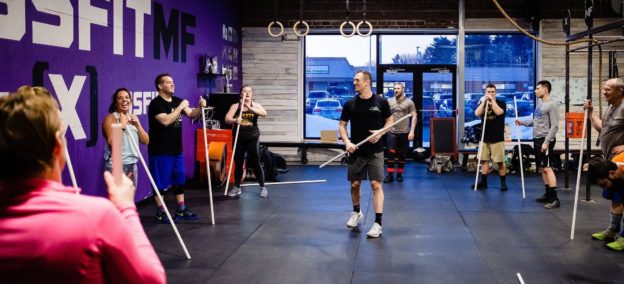
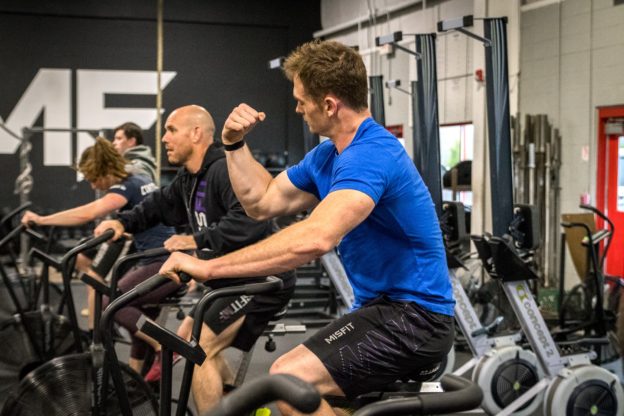
Responses